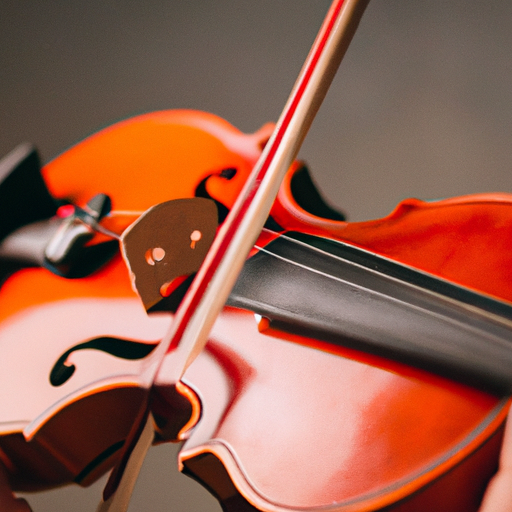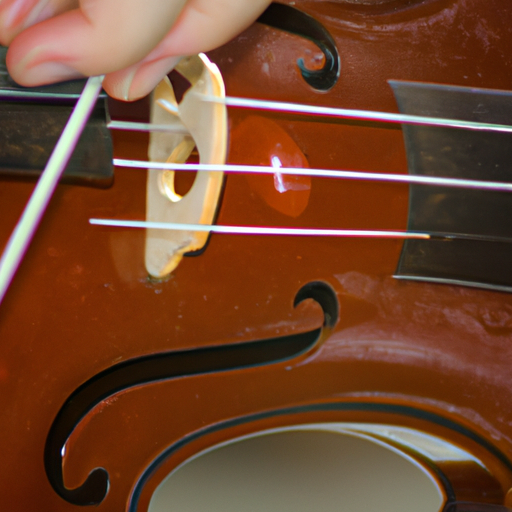
Learning to play the violin can be a challenging yet rewarding journey. Whether you're a complete beginner or have some musical background, having a strong foundation in violin playing is essential. In this article, we will provide you with easy violin tips that will help you improve your skills and progress in your violin journey.

A. The importance of having a good foundation in violin playing

Before diving into the tips, it's crucial to understand the significance of having a strong foundation in violin playing. Just like with any other musical instrument, building a solid base will allow you to progress and tackle more advanced techniques in the future. It will also help you develop proper posture and hand placement, produce accurate notes, and improve your overall musicality.
B. Who can benefit from the tips provided in this article
These easy violin tips are designed for beginners who are just starting their violin journey. However, they can also be valuable for intermediate players who want to refresh their knowledge and improve their technique. No matter what level you are at, it's always beneficial to revisit the basics and ensure a strong foundation.
A. The correct way to hold the violin and bow
Proper posture is crucial for producing a beautiful sound and preventing injuries. When holding the violin, your left hand should support the neck of the instrument while your chin rests on the chinrest. The violin should be parallel to the floor, with the scroll pointing slightly upwards. As for the bow, hold it with a relaxed grip, placing your thumb on the underside of the frog and your fingers resting gently on the top. Avoid gripping the bow too tightly, as it can restrict your bowing technique.
B. Tips on hand placement to produce clear and accurate notes
Hand placement is essential for producing clear and accurate notes on the violin. When placing your fingers on the fingerboard, make sure they are curved and resting on the tips. This will allow you to press down firmly on the strings without touching adjacent strings, resulting in clean and resonant pitches. Practice placing your fingers accurately by playing scales and simple melodies, focusing on maintaining a relaxed hand position.
A. Different types of bow strokes and when to use them
Mastering bowing techniques is crucial for creating various musical expressions on the violin. There are different types of bow strokes, including the full bow stroke, the half bow stroke, and the spiccato stroke. The full bow stroke is used for long, sustained notes, while the half bow stroke is ideal for shorter, detached notes. The spiccato stroke, on the other hand, is used for creating a bouncy and lively sound. Practice each bow stroke individually to understand their characteristics and when to use them in different musical passages.
B. Tips on how to maintain consistent bowing
Maintaining consistent bowing is essential for producing a smooth and even sound. To achieve this, pay attention to the angle and pressure of the bow on the strings. Start by practicing slow and controlled bow strokes, focusing on maintaining a consistent speed and pressure throughout. Gradually increase the tempo as you become more comfortable. It's also important to regularly check the straightness of your bowing arm and adjust if necessary.
A. The importance of tuning your violin regularly
Tuning your violin regularly is crucial for producing accurate and harmonious sounds. Even the slightest change in string tension can affect the overall tuning of the instrument. Make it a habit to tune your violin before each practice session or performance to ensure that you are playing in tune.
B. Tips on how to tune your violin using an electronic tuner or tuning fork
There are several methods to tune your violin, but the most common ones are using an electronic tuner or a tuning fork. An electronic tuner provides visual feedback, indicating whether each string is too high or too low in pitch. Simply pluck the string and adjust the tuning pegs accordingly. Alternatively, you can use a tuning fork to tune your violin. Strike the tuning fork against a solid object, place it on your violin's body, and adjust the pitch of each string until it matches the tone produced by the tuning fork.
A. Introduction to the fingerboard and its notes
The fingerboard is divided into various positions and contains different notes on each string. Understanding the fingerboard and its notes is essential for playing melodies and scales accurately. Familiarize yourself with the positions and notes by practicing scales and simple exercises that cover different areas of the fingerboard.
B. Tips on proper finger placement and hand positioning
Proper finger placement and hand positioning are crucial for producing clean and accurate notes. When pressing down a string, place your finger just behind the desired note, ensuring that it is firmly pressed against the fingerboard. Avoid pressing too hard, as it can cause the note to go sharp. Additionally, maintain a relaxed hand position and avoid tension in your fingers and wrist. Practice playing scales and simple melodies, paying attention to your finger placement and hand positioning.
A. Importance of practicing scales in violin playing
Practicing scales is essential for developing finger dexterity, improving intonation, and familiarizing yourself with different key signatures. Scales are fundamental building blocks in violin playing and provide a solid foundation for more advanced techniques. Make it a habit to practice scales in different keys, focusing on playing them smoothly and evenly.
B. Tips on how to practice scales effectively
When practicing scales, start slowly and gradually increase the tempo as you become more comfortable. Pay attention to the fingerings and aim for a clean and even sound on each note. Practice scales in various bowing styles, such as legato (smooth and connected), staccato (short and detached), and martelé (accented and controlled). Incorporate different bowing techniques to further develop your bowing skills.
A. Exercises to improve bowing skills
Bowing exercises are beneficial for improving bow control, dynamics, and overall technique. One effective exercise is the bowing on open strings, where you focus on producing a smooth and consistent sound using different bow strokes. Another exercise is the bowing on one string, where you practice playing long, sustained notes while maintaining a steady bow speed and pressure. These exercises will help you develop a solid foundation in bowing technique.
B. Tips on how to practice bowing exercises effectively
When practicing bowing exercises, start with slow and controlled movements, focusing on maintaining a consistent bow speed and pressure. Gradually increase the tempo as you become more comfortable. Pay attention to the sound quality and aim for a smooth and even sound. It's also beneficial to practice bowing exercises in different areas of the bow to develop control and flexibility.
A. Introduction to sheet music for violin players
Sheet music is a written representation of musical notes and instructions. Learning how to read sheet music is essential for violin players, as it allows you to play a wide range of repertoire and communicate effectively with other musicians. Familiarize yourself with the musical staff, note durations, key signatures, and other musical symbols commonly found in violin sheet music.
B. Tips on how to read sheet music and improve sight-reading skills
To improve your sheet music reading skills, start by practicing simple melodies and exercises. Focus on identifying the notes on the staff, the corresponding fingerings on the violin, and the rhythm of the piece. Gradually increase the complexity of the music as you become more comfortable. Sight-reading exercises, where you play unfamiliar music without prior practice, are also beneficial for improving your sight-reading skills.
A. The benefits of practicing with a metronome
Practicing with a metronome is essential for developing a sense of rhythm, precision, and consistency in your playing. It helps you maintain a steady tempo and prevents rushing or slowing down during performances. Regularly practicing with a metronome will improve your overall timing and make you a more reliable musician.
B. Tips on how to use a metronome effectively in violin practice
When using a metronome, start with a slow tempo and gradually increase the speed as you become more comfortable. Focus on playing precisely in time with the metronome, ensuring that each note aligns with the clicks. Practice scales, exercises, and pieces with the metronome, paying attention to your timing and rhythm. It's also beneficial to practice with different metronome subdivisions to further develop your sense of timing.
A. Summary of easy violin tips for beginners
In conclusion, building a strong foundation in violin playing is crucial for beginners. By following these easy violin tips, you will be able to improve your posture and hand placement, develop basic bowing techniques, tune your violin accurately, master essential finger placement, practice scales and bowing exercises effectively, read sheet music confidently, and enhance your rhythm and timing through metronome practice.
B. Encouragement to continue practicing and improving violin skills
Remember that learning the violin takes time and dedication. Practice regularly and be patient with yourself. Celebrate your progress and continue to challenge yourself with new techniques and repertoire. With perseverance and a love for music, you will continue to grow as a violinist. Enjoy the journey and embrace the beauty of playing the violin!
For more information about violin playing and tips, visit our website.